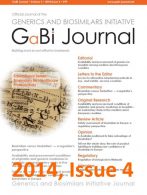GENERICS AND BIOSIMILARS INITIATIVE JOURNAL
Official Journal of the Generics and Biosimilars Initiative
Volume 3 / Year 2014 / Issue 4
Published articles:
- 2014/4 GaBI Journal Table of Contents (1)
- Abstracted Scientific Content (1)
- Commentary (1)
- Editor's Letter (1)
- Editorial (1)
- Interview (1)
- Letters to the Editor (1)
- Meeting Report (1)
- Opinion (2)
- Original Research (1)
- Pharma News (2)
- Regulatory (1)
- Review Article (1)



